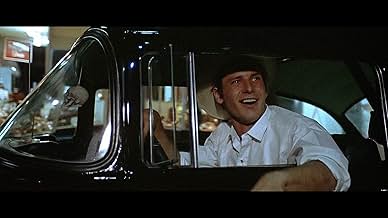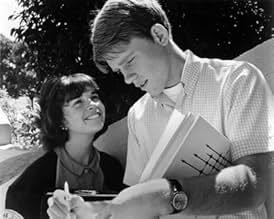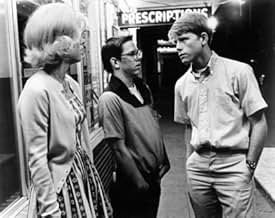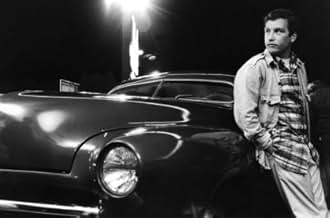American Graffiti
- 1973
- Tous publics
- 1h 50m
A group of teenagers in California's central valley spend one final night after their 1962 high school graduation cruising the strip with their buddies before they pursue their varying goals... Read allA group of teenagers in California's central valley spend one final night after their 1962 high school graduation cruising the strip with their buddies before they pursue their varying goals.A group of teenagers in California's central valley spend one final night after their 1962 high school graduation cruising the strip with their buddies before they pursue their varying goals.
- Director
- Writers
- Stars
- Nominated for 5 Oscars
- 9 wins & 13 nominations total
Ron Howard
- Steve
- (as Ronny Howard)
Charles Martin Smith
- Terry
- (as Charlie Martin Smith)
Terence McGovern
- Mr. Wolfe
- (as Terry McGovern)
Kathleen Quinlan
- Peg
- (as Kathy Quinlan)
- Director
- Writers
- All cast & crew
- Production, box office & more at IMDbPro
Featured reviews
"I just love it when guys peel out." -Debbie Dunham
American Graffiti is the best film about teenagers. It actually has a point, unlike the other teenage films where all that they do is get drunk and party. American Graffiti is about different types of teenagers doing different things on the last night that they all have together in 1962 after graduating. They all actually learn about themselves and what they want to do with their lives. One of the older
teenagers, Curt, is planning on leaving the next day. Steve is trying to work out his relationship with Curt's sister, while John and Terry have their own dates for the night. American Graffiti is a wonderful film on many levels. It is both funny and serious. A great direction by George Lucas and a fine cast with Ron
Howard, Richard Dreyfuss, Cindy Williams, Paul LeMat, Charles Martin Smith,
Candy Clark (Oscar-nominated), MacKenzie Phillips, Harrison Ford. One of the
best films of the 70's and the only teen film in my memory that has had the
pleasure of being nominated for Oscar- Best Picture. 10/10 stars.
American Graffiti is the best film about teenagers. It actually has a point, unlike the other teenage films where all that they do is get drunk and party. American Graffiti is about different types of teenagers doing different things on the last night that they all have together in 1962 after graduating. They all actually learn about themselves and what they want to do with their lives. One of the older
teenagers, Curt, is planning on leaving the next day. Steve is trying to work out his relationship with Curt's sister, while John and Terry have their own dates for the night. American Graffiti is a wonderful film on many levels. It is both funny and serious. A great direction by George Lucas and a fine cast with Ron
Howard, Richard Dreyfuss, Cindy Williams, Paul LeMat, Charles Martin Smith,
Candy Clark (Oscar-nominated), MacKenzie Phillips, Harrison Ford. One of the
best films of the 70's and the only teen film in my memory that has had the
pleasure of being nominated for Oscar- Best Picture. 10/10 stars.
The summer of 1962, for these four Youths, it's the closest they will ever get to the Garden of Eden. The music, the cars, the drinking, the dancing, and the innocence, American Graffiti is a harder film to make than Star Wars. To identify with the generation and to create truth from the characters, George Lucas's masterpiece is American Graffiti. From the town Big shot, the future Race car Driver, the Perfect Couple, and the local Nerd, it is amazing how the audience identifies with all these characters from out past. Like a page out of the high school year book, this movie jumps back into the early 60's, before the war, before the lines were drawn, the age of innocence in America would soon be coming to an end. This is the last party of the summer before the dream finally ends.
I was born at the beginning of the next decade--1970--yet "American Graffiti" was a chord that rippled throughout my life.
My father, who, like George Lucas, grew up in California's Central Valley, said this movie perfectly captured what it was like to grow up there--street cruising, hot rodding, picking up chicks, pulling pranks. Though this movie necessarily sidesteps the boredom inherent in growing up in the pesticide-choked San Joaquin Valley, the place itself is not as important the time it explores. It was a time just before the 1960s descended into the beginning of the end of American culture--the prototypical middle America that existed in almost all its small towns and now has substantively disappeared thanks to the urbanization and suburbanization of much of this country.
The ensemble cast, including so many that went on to become hugely successful in Hollywood--Ron Howard, Cindy Williams (well, with Laverne & Shirley at least), Richard Dreyfuss, and of course Harrison Ford (not to mention Lucas himself)--is handled with great skill from such a young director and reinforces the mystery why Lucas has so horribly mishandled Star Wars Eps. I and II. Lucas simply has been at the Ranch too long and his brilliant career has arrived parked in the garage at a large, entirely perfunctory business and media empire.
Anyway, regardless of Lucas' drift far away from the cutting edge, "American Graffiti" still stands as a kind of monument to his precocity. It is the kind of movie that hits every note with effortless precision, which I think is less the effort of great editing as it is a combination of youthful exuberance and actors and a director at essentially the beginning of their ascent as some of the best in the business.
This movie also withstands the test of time simply because it works magically both for those who have no particular emotional connection to the '60s and for those who were there on nearly equal levels. There is tremendous humor and naturalistic character play and dialog that few can help but be drawn into. Anyone with any sense of history will acknowledge that all the characters are standing at the edge of the deflowering and self-destruction of America in the '60s. It is a time of tremendous innocence, change, and harrowing decisions. The Bay of Pigs, Cuban Missile Crisis, and Vietnam haven't happened yet.
With Iraq and terrorism chewing at our consciousness every day, it's pretty easy for modern youth to identify and yearn for the nostalgia of such innocence.
My father, who, like George Lucas, grew up in California's Central Valley, said this movie perfectly captured what it was like to grow up there--street cruising, hot rodding, picking up chicks, pulling pranks. Though this movie necessarily sidesteps the boredom inherent in growing up in the pesticide-choked San Joaquin Valley, the place itself is not as important the time it explores. It was a time just before the 1960s descended into the beginning of the end of American culture--the prototypical middle America that existed in almost all its small towns and now has substantively disappeared thanks to the urbanization and suburbanization of much of this country.
The ensemble cast, including so many that went on to become hugely successful in Hollywood--Ron Howard, Cindy Williams (well, with Laverne & Shirley at least), Richard Dreyfuss, and of course Harrison Ford (not to mention Lucas himself)--is handled with great skill from such a young director and reinforces the mystery why Lucas has so horribly mishandled Star Wars Eps. I and II. Lucas simply has been at the Ranch too long and his brilliant career has arrived parked in the garage at a large, entirely perfunctory business and media empire.
Anyway, regardless of Lucas' drift far away from the cutting edge, "American Graffiti" still stands as a kind of monument to his precocity. It is the kind of movie that hits every note with effortless precision, which I think is less the effort of great editing as it is a combination of youthful exuberance and actors and a director at essentially the beginning of their ascent as some of the best in the business.
This movie also withstands the test of time simply because it works magically both for those who have no particular emotional connection to the '60s and for those who were there on nearly equal levels. There is tremendous humor and naturalistic character play and dialog that few can help but be drawn into. Anyone with any sense of history will acknowledge that all the characters are standing at the edge of the deflowering and self-destruction of America in the '60s. It is a time of tremendous innocence, change, and harrowing decisions. The Bay of Pigs, Cuban Missile Crisis, and Vietnam haven't happened yet.
With Iraq and terrorism chewing at our consciousness every day, it's pretty easy for modern youth to identify and yearn for the nostalgia of such innocence.
Whether you love this movie or not, you have to admire this movie for two reasons. First, its return on the dollar was among the best ever for any film. While the budget was a very modest $777,777.111 (no kidding), it returned $115,000,000 in the United States alone! No wonder this film made George Lucas famous. Second, it was very innovative. While I was not a huge fan of the film's style, it was unique and sure had an impact on the world as well as future films. No one had made a film like this before--chock full of one song after another blaring across the soundtrack and its odd semi-structureless plot was also quite unique.
The film concerns a bunch of young adults just hanging out and cruising. There really isn't a lot more to it than that. Sure, their stories all reveal a bit about them through the course of the film, but most of the characters have no great depth. It's more like you are a voyeur watching some likable and not especially likable kids doing...well...nothing. Now if you grew up in the early 60s and remember all this, then it's a great stroll down memory lane. If you didn't, I think the movie will be more of a tough sell, as the nostalgia angle is non-existent. As for me, I wasn't even born until 1964, so the nostalgia aspect was less--but I loved the music and great cars. My daughter, while less impressed about EVERYTHING did grudgingly say that the music was great. She also said that she pretty much ignored the plot and just listened to the songs! And, perhaps, this is pretty typical of a person from her generation. As for me, the film was mildly interesting and I respect it--though I did not love it. This isn't really meant as a criticism--just a statement about how this film appealed to this 47 year-old guy. For the right audience, it's the perfect film. Otherwise, you might feels it's all a bit overrated.
Aside from the nostalgia for the early 60s, the movie also is quite interesting when seen today because so many future stars and super-stars are in it--mostly when they were young unknowns. Ron Howard (a child star but not all that popular yet as an adult), Cindy Williams, Harrison Ford, Richard Dreyfus, Charles Martin Smith, Mackenzie Phillips and Suzanne Somers all appear in the film.
The film concerns a bunch of young adults just hanging out and cruising. There really isn't a lot more to it than that. Sure, their stories all reveal a bit about them through the course of the film, but most of the characters have no great depth. It's more like you are a voyeur watching some likable and not especially likable kids doing...well...nothing. Now if you grew up in the early 60s and remember all this, then it's a great stroll down memory lane. If you didn't, I think the movie will be more of a tough sell, as the nostalgia angle is non-existent. As for me, I wasn't even born until 1964, so the nostalgia aspect was less--but I loved the music and great cars. My daughter, while less impressed about EVERYTHING did grudgingly say that the music was great. She also said that she pretty much ignored the plot and just listened to the songs! And, perhaps, this is pretty typical of a person from her generation. As for me, the film was mildly interesting and I respect it--though I did not love it. This isn't really meant as a criticism--just a statement about how this film appealed to this 47 year-old guy. For the right audience, it's the perfect film. Otherwise, you might feels it's all a bit overrated.
Aside from the nostalgia for the early 60s, the movie also is quite interesting when seen today because so many future stars and super-stars are in it--mostly when they were young unknowns. Ron Howard (a child star but not all that popular yet as an adult), Cindy Williams, Harrison Ford, Richard Dreyfus, Charles Martin Smith, Mackenzie Phillips and Suzanne Somers all appear in the film.
American Graffiti, voted in 1998 to the American Film Institute's list of 100 superlative films, is as good today as it was upon its release in 1973. Countless films (such as Linklater's excellent Dazed and Confused) have borrowed heavily from Lucas' blueprint of multiple characters and storylines punctuated by wall to wall rock music. If possible, you should try to see the 1998 documentary that accompanies the DVD release, as it provides a wealth of information directly from Lucas, Coppola, LeMat, Ford, Clark, Dreyfuss, Howard, and many others about the creation of the film from concept to box-office phenomenon.
The Life and Times of Harrison Ford
The Life and Times of Harrison Ford
Take a look back at Harrison Ford's movie career in photos.
Did you know
- TriviaDue to the low budget, George Lucas was unable to pay all of the crew members. He offered to give many of them a screen credit in lieu of payment, and they accepted. Traditionally, only department heads received screen credit. Giving screen credit to all crew members is now standard, which is why closing credits last so much longer now.
- GoofsThe movie is set in 1962, but a cinema marquee advertises Dementia 13 (1963) (released in 1963). This was done on purpose by George Lucas, because Dementia 13 was Producer Francis Ford Coppola's first movie.
- Quotes
Curt Henderson: You're the most beautiful, exciting thing I've ever seen in my life and I don't know anything about you.
- Crazy creditsWorded epilogues prior to the credits shows what happen to the characters following the movie. While this has since become commonplace in films, it was considered innovative at the time.
- Alternate versionsOriginally released at 110 minutes; re-edited and re-released in a slightly longer version (112 minutes) in 1978 when many of its then-unknown stars became famous.
- ConnectionsFeatured in 747 en péril (1974)
- SoundtracksAt The Hop
Written by John Madara, Artie Singer and Dave White (uncredited)
Performed by Flash Cadillac (as Flash Cadillac and The Continental Kids)
Produced by Kim Fowley
Courtesy of Roulette Records:
Details
- Release date
- Country of origin
- Language
- Also known as
- American Graffiti: Locura de verano
- Filming locations
- Production companies
- See more company credits at IMDbPro
Box office
- Budget
- $750,000 (estimated)
- Gross US & Canada
- $115,000,000
- Gross worldwide
- $115,006,690
- Runtime
- 1h 50m(110 min)
- Color
- Aspect ratio
- 2.39 : 1
Contribute to this page
Suggest an edit or add missing content








































